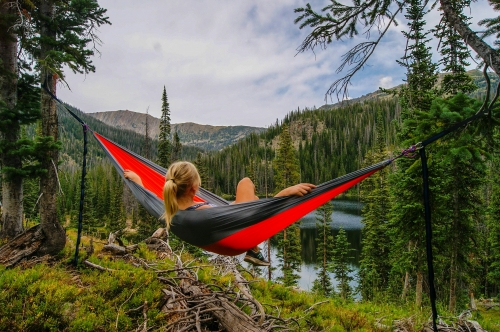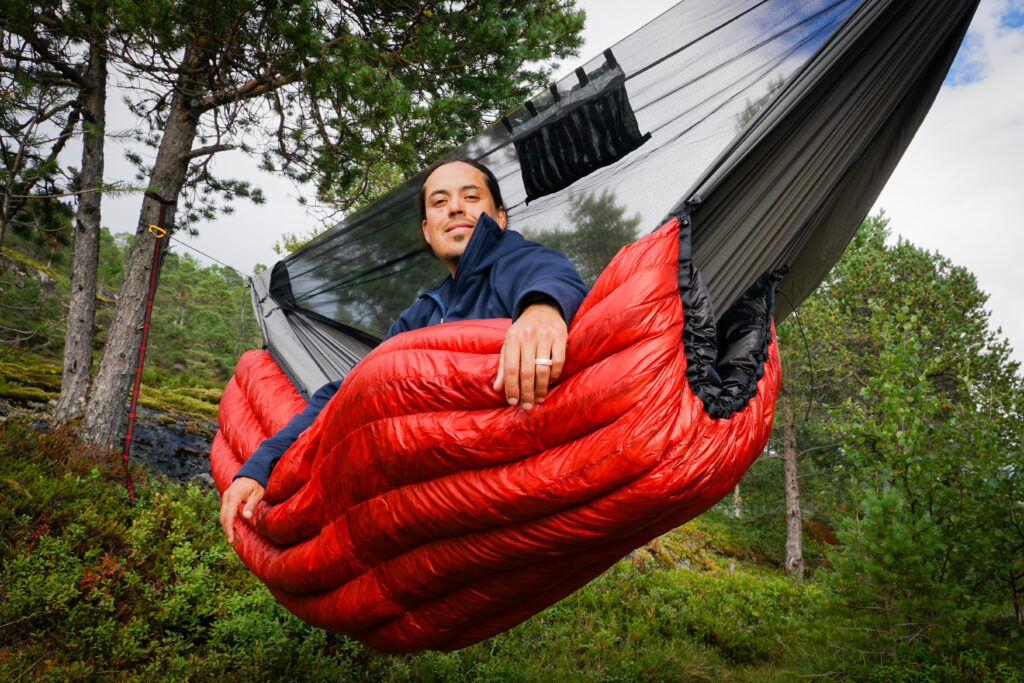Lighter Backpacking, Better Sleep: Why Switch to Hammock Camping

Leave the bulky tent behind and wake up feeling refreshed! Hammock camping offers a surprisingly comfortable backpacking experience. Imagine swaying gently in the breeze beneath a canopy of stars. Not only is hammock camping lighter on your back, but it also allows you to sleep on uneven terrain and avoid creepy crawlies. Intrigued? Read on to discover the transformative world of hammock camping, and learn how to shed pounds from your pack and enjoy a blissful sleep under the stars.
Traditional backpacking involves carrying heavy loads on one’s back while navigating through rugged terrain and setting up camp with a tent. While this method has been the go-to for outdoor enthusiasts for years, it presents several challenges. These challenges include the weight of traditional gear, finding suitable camping spots, and struggling with discomfort during sleep due to uneven terrain or uncomfortable sleeping surfaces.
“Last summer, the Appalachian Trail threw everything at my tent: rain, wind, and a frustratingly uneven campsite. Sleep was elusive. Enter hammock camping! On my next trip, I swapped my tent for a hammock with a bug net and tarp. The weight difference was dramatic – 2 lbs lighter! Setting up was quicker, and the hammock cradled me comfortably over the rocky ground. I slept soundly, finally waking up to a breathtaking sunrise filtering through the trees. Hammock camping became my new wilderness haven.”
Enter hammock camping, a modern solution to the discomforts of traditional backpacking. Hammock camping involves sleeping in a suspended hammock instead of a tent pitched on the ground. It offers a lightweight and versatile alternative that addresses many of the challenges faced by traditional backpackers. With hammock camping, outdoor enthusiasts can enjoy a more comfortable and enjoyable experience while spending time in nature.
Understanding Hammock Camping
Hammock camping is the practice of sleeping in a hammock instead of a traditional tent while camping outdoors. While hammocks have been used for centuries in various cultures for relaxation and sleep, the concept of hammock camping as a recreational activity has gained popularity in recent years. Originating from indigenous cultures in regions such as Central and South America, hammocks were initially used as beds to keep sleepers off the ground and away from insects and animals. Today, hammock camping has evolved into a modern outdoor activity embraced by adventurers seeking a lightweight and comfortable alternative to traditional tent camping.
Components of a Hammock Camping Setup
A typical hammock camping setup consists of three main components: the hammock itself, the suspension system, and various accessories. The hammock is the primary sleeping platform, usually made from lightweight, durable materials such as nylon or polyester. It is designed to support the weight of the camper while providing a comfortable sleeping surface. The suspension system includes straps or ropes that attach the hammock to trees or other sturdy anchor points, allowing for easy setup and adjustment. Accessories such as rain flies, bug nets, and underquilts can be added to enhance comfort and protection from the elements, making the hammock camping experience even more enjoyable and versatile.
Advantages of Hammock Camping Over Traditional Tent Camping
Hammock camping offers several advantages over traditional tent camping, making it an appealing option for outdoor enthusiasts. Firstly, hammocks are significantly lighter and more compact than tents, making them ideal for backpackers and hikers looking to reduce pack weight and save space. Additionally, hammocks can be set up in a wider variety of terrain, including rocky or uneven ground, where tent pitching may be challenging or impossible. Hammock camping also provides better ventilation and airflow, reducing condensation and minimizing the risk of moisture buildup inside the shelter. Furthermore, sleeping in a hammock offers a unique and immersive experience, allowing campers to sway gently with the breeze and enjoy uninterrupted views of the surrounding landscape. Overall, the advantages of hammock camping, including weight savings, versatility, and comfort, make it an attractive alternative to traditional tent camping for outdoor adventurers seeking a lighter and more enjoyable camping experience.
Lighter Backpacking with Hammock Camping
One of the most significant advantages of hammock camping for backpackers is the reduction in pack weight compared to traditional tent systems. A typical hammock setup, including the hammock, suspension system, and accessories, can weigh significantly less than a traditional tent, poles, and ground tarp. This weight savings is especially valuable for backpackers looking to minimize the load they carry on long-distance hikes or multi-day treks. By switching to a hammock camping system, backpackers can enjoy a lighter pack without sacrificing comfort or protection from the elements, making their outdoor adventures more enjoyable and manageable.
Compactness and Ease of Packing for Hammock Gear
In addition to being lighter, hammock camping gear is also more compact and easier to pack compared to traditional tent systems. Hammocks can be rolled or stuffed into a small stuff sack, along with the suspension system and accessories, taking up minimal space in a backpack. This compactness is especially beneficial for backpackers who need to carefully manage their pack space and prioritize lightweight and versatile gear. With hammock camping gear, backpackers can spend less time wrestling with bulky tents and more time enjoying the beauty of the outdoors, making their camping experience more streamlined and efficient.
Exploring the Benefits of Reducing Pack Weight for Backpackers
Reducing pack weight is a game-changer for backpackers, offering a multitude of benefits that enhance the overall outdoor experience. Firstly, lighter packs reduce physical strain and fatigue, allowing backpackers to cover more miles with less effort and discomfort. This increased mobility and endurance open up new possibilities for exploration and adventure, whether it’s summiting a challenging peak or traversing rugged terrain. Additionally, lighter packs enable backpackers to carry essential safety gear, extra food and water, and other necessities without exceeding their physical limits. This preparedness can be crucial in emergency situations or unexpected weather conditions, ensuring backpackers stay safe and comfortable throughout their journey. Moreover, reducing pack weight promotes a more sustainable approach to outdoor recreation by minimizing the environmental impact of excessive gear and supplies. By embracing lightweight backpacking practices, backpackers can tread lightly on the land, leaving behind only footprints and memories of their wilderness adventures.
“Hammock camping has been a game-changer for me. It’s lighter than my tent, and I can find comfortable sleeping spots almost anywhere.”
Improving Sleep Quality in the Wilderness
Hammock sleeping offers superior ergonomics compared to sleeping on the ground, providing a more comfortable and supportive sleeping surface for outdoor enthusiasts. When lying in a hammock, the body is naturally positioned in a slight curve, which promotes proper spinal alignment and reduces pressure points. This ergonomic design helps alleviate back pain and discomfort often associated with sleeping on uneven or hard ground. Additionally, hammocks gently cradle the body, distributing weight evenly and minimizing stress on joints, muscles, and ligaments. As a result, campers can enjoy a more restful and rejuvenating night’s sleep, waking up feeling refreshed and ready to tackle the day’s adventures.
Benefits of Sleeping Elevated: Avoiding Rocks, Roots, and Uneven Terrain
Sleeping elevated in a hammock offers numerous benefits for wilderness sleepers, including protection from rocks, roots, and uneven terrain. Unlike traditional tent camping, where campers are susceptible to uncomfortable sleeping surfaces and potential hazards on the ground, hammock campers rest safely above the forest floor. This elevation not only provides a smoother and more level sleeping surface but also eliminates the risk of encountering sharp objects or protruding rocks that can disrupt sleep and cause discomfort. By sleeping elevated in a hammock, outdoor enthusiasts can enjoy peace of mind knowing they are sheltered from ground-related hazards, allowing for a more secure and tranquil sleeping experience in the wilderness.
Enhancing Comfort and Relaxation for Better Sleep Outdoors
Hammock camping offers unparalleled comfort and relaxation for outdoor enthusiasts seeking a more enjoyable and restorative sleep experience in the wilderness. With the gentle sway of the hammock and the soothing sounds of nature surrounding them, campers can easily drift off into a deep and restful slumber, free from the distractions and discomforts of traditional tent camping. Additionally, hammocks provide excellent ventilation and airflow, keeping campers cool and comfortable throughout the night, even in warm or humid conditions. Furthermore, hammocks offer the flexibility to adjust sleeping positions and angles to suit individual preferences, allowing campers to find their perfect sleeping position for optimal comfort and relaxation. By enhancing comfort and relaxation, hammock camping promotes better sleep quality outdoors, ensuring campers wake up feeling energized and ready to take on the day’s adventures with renewed vitality and enthusiasm.
Environmental Considerations
Hammock camping aligns perfectly with the principles of Leave No Trace, emphasizing minimal impact camping practices that protect and preserve the natural environment. Unlike traditional tent camping, which requires clearing vegetation and flattening the ground, hammock camping minimizes ground disturbance by suspending campers above the forest floor. This reduces damage to fragile ecosystems and minimizes the disruption of wildlife habitats, allowing nature to thrive undisturbed. Additionally, hammock campers adhere to Leave No Trace principles by properly disposing of waste, using biodegradable soaps, and avoiding unnecessary noise and disturbance to wildlife. By embracing minimal impact camping with hammock systems, outdoor enthusiasts can enjoy the wilderness responsibly while leaving behind only footprints.
Preserving Delicate Ecosystems with Reduced Ground Disturbance
Hammock camping offers a sustainable alternative to traditional tent camping by reducing ground disturbance and minimizing the impact on delicate ecosystems. Unlike tents, which require campsites to be cleared of vegetation and leveled for pitching, hammocks can be set up without altering the natural landscape. This preserves soil structure, prevents erosion, and protects plant roots and microorganisms essential for ecosystem health. By minimizing ground disturbance, hammock campers help preserve delicate ecosystems, ensuring that future generations can continue to enjoy the beauty and biodiversity of the wilderness.
Sustainable Materials and Eco-Friendly Practices in Hammock Camping Gear
In recent years, there has been a growing trend toward sustainability in outdoor gear, including hammock camping equipment. Manufacturers are increasingly using eco-friendly materials such as recycled nylon and organic cotton to produce hammocks and accessories. Additionally, many companies prioritize sustainable manufacturing practices, such as reducing waste, conserving water and energy, and sourcing materials responsibly. Hammock campers can further minimize their environmental impact by choosing gear from companies committed to sustainability and practicing eco-friendly habits such as repairing gear instead of replacing it and minimizing packaging waste. By prioritizing sustainable materials and practices in hammock camping gear, outdoor enthusiasts can reduce their carbon footprint and contribute to the conservation of natural resources while enjoying the beauty of the great outdoors.
Tips for Transitioning to Hammock Camping
When transitioning to hammock camping, choosing the right hammock and suspension system is crucial for a comfortable and enjoyable outdoor experience. Consider factors such as hammock size, weight capacity, and material durability to ensure compatibility with your body size and sleeping preferences. Look for hammocks with integrated bug nets and rain flies for added protection from insects and the elements. Additionally, invest in a reliable suspension system, such as tree straps or whoopie slings, that offers easy setup and adjustability. Take the time to research different hammock brands and models to find the perfect fit for your needs and budget, ensuring a successful transition to hammock camping.
Essential Accessories and Gear for a Comfortable Hammock Camping Experience
In addition to a hammock and suspension system, several essential accessories and gear items can enhance your hammock camping experience. Invest in a quality sleeping pad or underquilt to provide insulation and warmth underneath your hammock, especially in cooler weather. A top quilt or sleeping bag designed for hammock camping will keep you cozy and comfortable throughout the night. Consider adding a pillow or stuff sack filled with clothes for extra neck support and comfort. Other essential accessories include a lightweight camping stove, cookware, and food storage bags to prepare meals and snacks while camping. With the right gear and accessories, hammock camping can be a luxurious and comfortable outdoor experience.
Practicing Setup and Adjustment Techniques for Optimal Sleep and Relaxation
Before embarking on your first hammock camping trip, take the time to practice setup and adjustment techniques to ensure optimal sleep and relaxation in your hammock. Experiment with different suspension angles and hammock positions to find the most comfortable and supportive setup for your body. Practice tying knots and adjusting tension in your suspension system to achieve the perfect hang every time. Consider setting up your hammock in your backyard or a local park to familiarize yourself with the process and make any necessary adjustments. By mastering setup and adjustment techniques, you’ll be able to enjoy a restful night’s sleep and maximum relaxation in your hammock, making the transition to hammock camping seamless and enjoyable.
Transitioning to hammock camping offers outdoor enthusiasts a lightweight, comfortable, and versatile alternative to traditional tent camping. By selecting the right hammock and suspension system, investing in essential accessories and gear, and practicing setup and adjustment techniques, campers can enjoy a luxurious and restful outdoor experience in their hammock. Whether you’re a seasoned backpacker or new to camping, hammock camping offers a unique and enjoyable way to connect with nature and rejuvenate body and mind amidst the beauty of the great outdoors.
Real-World Experiences
Hammock camping enthusiasts around the world share their personal anecdotes and testimonials, highlighting the unique benefits and experiences of sleeping in a hammock. From the thrill of swaying gently in the breeze to the unparalleled comfort and relaxation, hammock campers rave about the transformative power of hammock camping. Many recount memorable nights spent under the stars, cocooned in their hammock, listening to the soothing sounds of nature all around them. Experienced hammock campers share tips and tricks for achieving the perfect hang, overcoming challenges, and maximizing comfort in the wilderness. Their stories inspire and encourage newcomers to embrace hammock camping as a rewarding and enjoyable outdoor adventure.
Case Studies Comparing Sleep Quality and Comfort Between Hammock and Tent Camping
Numerous case studies and scientific research have compared sleep quality and comfort between hammock and tent camping, providing valuable insights into the benefits of hammock camping. Studies consistently show that hammock camping promotes deeper, more restful sleep compared to tent camping, thanks to the ergonomic design and suspended sleeping position of hammocks. Researchers have found that hammock campers experience fewer pressure points and better spinal alignment, leading to reduced discomfort and improved sleep quality throughout the night. Additionally, studies highlight the superior ventilation and airflow of hammocks, which helps regulate body temperature and minimize condensation, further enhancing sleep comfort in various weather conditions. These findings underscore the advantages of hammock camping for achieving optimal sleep and relaxation in the wilderness.
Highlighting the Versatility and Adaptability of Hammock Camping in Various Environments
Hammock camping offers unparalleled versatility and adaptability, allowing outdoor enthusiasts to sleep comfortably in a wide range of environments and terrain. Whether it’s nestled between trees in a lush forest, suspended over rocky terrain in the mountains, or strung up on a sandy beach, hammocks can be set up virtually anywhere, providing a comfortable and secure sleeping option in diverse landscapes. Hammock campers share stories of their adventures in remote wilderness areas, urban parks, and everything in between, demonstrating the versatility of hammock camping as a practical and enjoyable outdoor accommodation solution. From backpacking trips to car camping excursions, hammock camping offers flexibility and freedom to explore the great outdoors with ease and comfort.
Real-world experiences from hammock campers, along with case studies and scientific research, highlight the unique benefits and advantages of hammock camping for achieving optimal sleep quality and comfort in the wilderness. From personal testimonials to empirical evidence, the consensus is clear: hammock camping offers a transformative and enjoyable outdoor experience that is unmatched by traditional tent camping. Whether you’re a seasoned adventurer or new to camping, consider embracing hammock camping for your next outdoor adventure and discover the joys of sleeping under the stars in a cozy hammock cocoon.
Getaway With Friends
Hammock camping offers a myriad of benefits for outdoor enthusiasts seeking lighter backpacking and better sleep in the wilderness. By transitioning to hammock camping, adventurers can enjoy reduced pack weight, improved sleep quality, and enhanced comfort compared to traditional tent camping. The ergonomic design of hammocks promotes proper spinal alignment and reduces pressure points, leading to a more restful and rejuvenating night’s sleep.
As hammock camping continues to gain popularity among outdoor enthusiasts, its future looks bright and promising. With advancements in gear technology, sustainable manufacturing practices, and a growing community of hammock campers, the possibilities for hammock camping are endless. Whether you’re embarking on a solo backpacking trip, a family camping adventure, or a weekend getaway with friends, hammock camping offers a comfortable, convenient, and enjoyable outdoor accommodation solution.
So ditch the heavy tent, embrace the gentle sway, and see for yourself why hammock camping is the secret weapon of backpackers. With a lighter pack and a more comfortable sleep, you’ll be amazed at how much further you can hike and how much more you can enjoy the wilderness. Imagine waking up to a sunrise vista with a smile – that’s the magic of hammock camping waiting for you.
You may also be interested in: Outdoor Camping Gear & Accessories | Hammock Gear
Embark on your next adventure with Hammock Gear’s custom quilts! Tailor your comfort for the wild – choose your style, warmth, and size to craft your perfect eco-friendly outdoor companion, or grab a complete ultralight kit. Made in the USA for unparalleled quality and comfort. Trusted since 2009. Shop Now and tap into a community of nature lovers!
Related Posts
The Best Camping Hammocks of 2024 – A Buyer’s Guide by Hammock Gear
A good camping hammock can completely transform how you experience…
Can Napping Hurt You? Unveiling the Pros & Cons of Daily Zzz’s
Napping, the act of taking a brief sleep during the…


